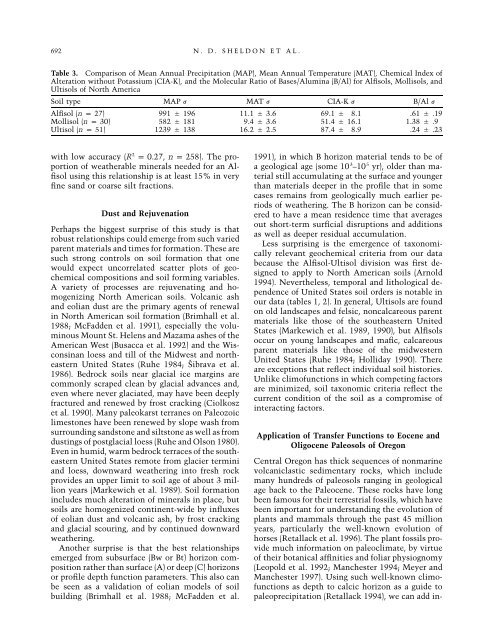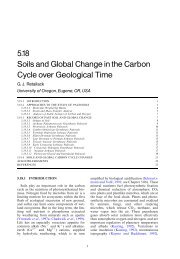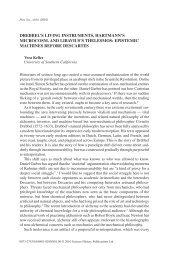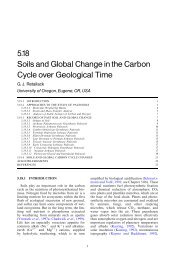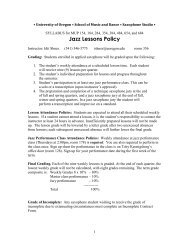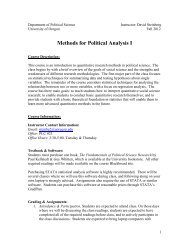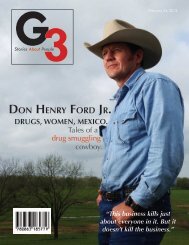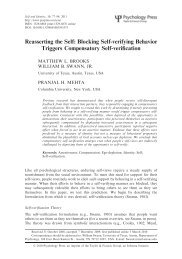Geochemical Climofunctions from North American Soils and ...
Geochemical Climofunctions from North American Soils and ...
Geochemical Climofunctions from North American Soils and ...
- No tags were found...
Create successful ePaper yourself
Turn your PDF publications into a flip-book with our unique Google optimized e-Paper software.
692 N. D. SHELDON ET AL.Table 3. Comparison of Mean Annual Precipitation (MAP), Mean Annual Temperature (MAT), Chemical Index ofAlteration without Potassium (CIA-K), <strong>and</strong> the Molecular Ratio of Bases/Alumina (B/Al) for Alfisols, Mollisols, <strong>and</strong>Ultisols of <strong>North</strong> AmericaSoil type MAP j MAT j CIA-K j B/Al jAlfisol (n p 27) 991 196 11.1 3.6 69.1 8.1 .61 .19Mollisol (n p 30) 582 181 9.4 3.6 51.4 16.1 1.38 .9Ultisol (n p 51) 1239 138 16.2 2.5 87.4 8.9 .24 .232with low accuracy ( R p 0.27, n p 258). The proportionof weatherable minerals needed for an Alfisolusing this relationship is at least 15% in veryfine s<strong>and</strong> or coarse silt fractions.Dust <strong>and</strong> RejuvenationPerhaps the biggest surprise of this study is thatrobust relationships could emerge <strong>from</strong> such variedparent materials <strong>and</strong> times for formation. These aresuch strong controls on soil formation that onewould expect uncorrelated scatter plots of geochemicalcompositions <strong>and</strong> soil forming variables.A variety of processes are rejuvenating <strong>and</strong> homogenizing<strong>North</strong> <strong>American</strong> soils. Volcanic ash<strong>and</strong> eolian dust are the primary agents of renewalin <strong>North</strong> <strong>American</strong> soil formation (Brimhall et al.1988; McFadden et al. 1991), especially the voluminousMount St. Helens <strong>and</strong> Mazama ashes of the<strong>American</strong> West (Busacca et al. 1992) <strong>and</strong> the Wisconsinanloess <strong>and</strong> till of the Midwest <strong>and</strong> northeasternUnited States (Ruhe 1984; Šibrava et al.1986). Bedrock soils near glacial ice margins arecommonly scraped clean by glacial advances <strong>and</strong>,even where never glaciated, may have been deeplyfractured <strong>and</strong> renewed by frost cracking (Ciolkoszet al. 1990). Many paleokarst terranes on Paleozoiclimestones have been renewed by slope wash <strong>from</strong>surrounding s<strong>and</strong>stone <strong>and</strong> siltstone as well as <strong>from</strong>dustings of postglacial loess (Ruhe <strong>and</strong> Olson 1980).Even in humid, warm bedrock terraces of the southeasternUnited States remote <strong>from</strong> glacier termini<strong>and</strong> loess, downward weathering into fresh rockprovides an upper limit to soil age of about 3 millionyears (Markewich et al. 1989). Soil formationincludes much alteration of minerals in place, butsoils are homogenized continent-wide by influxesof eolian dust <strong>and</strong> volcanic ash, by frost cracking<strong>and</strong> glacial scouring, <strong>and</strong> by continued downwardweathering.Another surprise is that the best relationshipsemerged <strong>from</strong> subsurface (Bw or Bt) horizon compositionrather than surface (A) or deep (C) horizonsor profile depth function parameters. This also canbe seen as a validation of eolian models of soilbuilding (Brimhall et al. 1988; McFadden et al.1991), in which B horizon material tends to be of3 5a geological age (some 10 –10 yr), older than materialstill accumulating at the surface <strong>and</strong> youngerthan materials deeper in the profile that in somecases remains <strong>from</strong> geologically much earlier periodsof weathering. The B horizon can be consideredto have a mean residence time that averagesout short-term surficial disruptions <strong>and</strong> additionsas well as deeper residual accumulation.Less surprising is the emergence of taxonomicallyrelevant geochemical criteria <strong>from</strong> our databecause the Alfisol-Ultisol division was first designedto apply to <strong>North</strong> <strong>American</strong> soils (Arnold1994). Nevertheless, temporal <strong>and</strong> lithological dependenceof United States soil orders is notable inour data (tables 1, 2). In general, Ultisols are foundon old l<strong>and</strong>scapes <strong>and</strong> felsic, noncalcareous parentmaterials like those of the southeastern UnitedStates (Markewich et al. 1989, 1990), but Alfisolsoccur on young l<strong>and</strong>scapes <strong>and</strong> mafic, calcareousparent materials like those of the midwesternUnited States (Ruhe 1984; Holliday 1990). Thereare exceptions that reflect individual soil histories.Unlike climofunctions in which competing factorsare minimized, soil taxonomic criteria reflect thecurrent condition of the soil as a compromise ofinteracting factors.Application of Transfer Functions to Eocene <strong>and</strong>Oligocene Paleosols of OregonCentral Oregon has thick sequences of nonmarinevolcaniclastic sedimentary rocks, which includemany hundreds of paleosols ranging in geologicalage back to the Paleocene. These rocks have longbeen famous for their terrestrial fossils, which havebeen important for underst<strong>and</strong>ing the evolution ofplants <strong>and</strong> mammals through the past 45 millionyears, particularly the well-known evolution ofhorses (Retallack et al. 1996). The plant fossils providemuch information on paleoclimate, by virtueof their botanical affinities <strong>and</strong> foliar physiognomy(Leopold et al. 1992; Manchester 1994; Meyer <strong>and</strong>Manchester 1997). Using such well-known climofunctionsas depth to calcic horizon as a guide topaleoprecipitation (Retallack 1994), we can add in-


